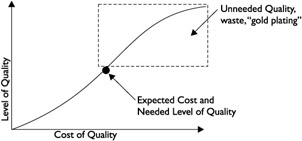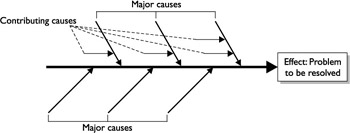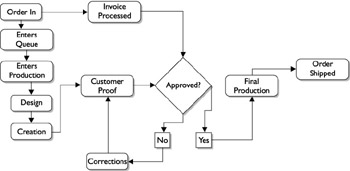Planning for Quality
|
| < Day Day Up > |
|
Once the project manager has assembled the needed inputs, and evaluated the product description and project scope, he can get to work creating a plan on how to satisfy the quality demands. He’ll need to rely on the documentation created to date, his project team, and the project’s key stakeholder for much of the input. In addition, the project manager will use several different techniques to plan on meeting quality.
As planning is an iterative process, so too is quality planning. As events happen within the project, the project manager should evaluate the events and then apply corrective actions. This is a common PMI theme: plan, implement, measure, react—and document! Throughout the project implementation, things will go awry, team members may complete less-than-acceptable work, stakeholders will demand changes, and so on; all of these variables must be evaluated for their impact on project quality. What good is a project if it’s “completed” on time, but the quality of the deliverable is unacceptable? Technically, if the product is unacceptable, the project is not finished since it failed to meet the project scope. Let’s look at some tools and techniques the project manager will use to plan for quality.
Using a Benefit/Cost Analysis
Benefits should outweigh costs.
A benefit/cost analysis is a process of determining the pros and cons of any process, product, or activity. The straightforward approach, when it comes to project management, is concerned with the benefits of quality management activities versus the costs of the quality management activities. There are two major considerations with the benefit/cost analysis in quality management:
-
Benefit Completing quality work increases productivity because shoddy work does not have to be redone. When work is completed correctly the first time, as expected, the project does not have to spend additional funds to redo the work.
-
Costs Completing quality work may cost more monies than the work is worth. To deliver a level of quality beyond what is demanded costs the project additional funds. The types of quality management activities that guarantee quality may not be needed for every project.
-
Gold plating The customer does not need or want more than what was requested. Gold plating is the process of adding extra features that may drive up costs and alter schedules. The project team should strive to deliver what was expected.

While quality is needed on every project, not every project has the same quality expenses based on the demands. For example, consider a project to create a temporary drainage ditch for a field. There are specifications for the ditch, but the project may not require the expense of a landscape architect to evaluate the slant and descent of the temporary ditch.
Another project, to create and secure an information technology department, may require the expense of a security consulting firm to evaluate, test, and certify the security of the software code, the network servers, and the physical security of the department. The cost of the quality requirements is in alignment with the demands of the project.
Applying Benchmarking Practices
Benchmarking, when it comes to quality project management, is all about comparing this project to another. Benchmarking is a technique to take what the project manager has planned or experienced regarding quality and compare it to another project to see how things measure up. The current project can be measured against any other project—not just projects within the performing organization or within the same industry.
The goal of benchmarking is to evaluate the differences between the two projects and then to make corrective actions to the current project. For example, Project A may have better quality performance than Project B. When the project manager compares the two projects, he’ll want to find out what the differences are between them. He’ll look for what’s missing in Project B, or what activities the folks in Project A are doing that he’s not.
Benchmarking allows the project manager and the project team to see what’s possible and then strive toward that goal. Benchmarking can also be used as a measurement against industry standards, competitors’ pricing, or competitors’ level of performance.
| On the Job | Benchmarking, if used improperly, can create some false goals and internal competition. If the projects that are being compared to each other are active, truth in reporting is mandatory; otherwise, the results of the benchmarking will be skewed. Ideally, benchmarking is compared against similar, completed projects early in the quality planning, rather than late in the process. |
Creating a Flow Chart
Technically, a flow chart is any diagram illustrating how components within a system are related. An organizational flow chart shows the bottom crew of operations up to the “little squirt” on top. A HVAC blueprint shows how the air flows through a building from the furnace to each room. Flow charts show the relation between components, as well as help the project team determine where quality issues may be present and, once done, plan accordingly.
There are two types of flow charts you’ll need to be concerned with for this exam:
-
Cause-and-effect diagrams These diagrams show the relation between the variables within a process and how those relations may contribute to inadequate quality. This diagram can help organize both the process and team opinions, as well as generate discussion on finding a solution to ensure quality. Figure 8-1 is an example of a cause-and-effect diagram. These diagrams are also known as Ishikawa diagrams and fishbone diagrams.

Figure 8-1: Cause-and-effect diagrams show the relation of variables to the quality problem. -
System or process flow charts These flow charts illustrate the flow of a process through a system, such as a project change request through the change control system, or work authorization through a quality control process. A process flow chart does not have to be limited to the project management activities; a process flow chart could demonstrate how a manufacturer creates, packages, and ships the product to the customer as seen in Figure 8-2.

Figure 8-2: Process flow charts illustrate how a system process unfolds.
Exam Watch
A cause-and-effect diagram is also called an Ishikawa diagram. Same thing; fancier name.
Design of Experiments
The design of experiments approach relies on statistical what-if scenarios to determine what variables within a project will result in the best outcome. Design of experiments approach is most often used on the product of the project, rather than the project itself. For example, a project team creating a new bicycle may experiment with the width of the tires, the weight of the frame, and the position of the handlebars in relation to the bike seat to determine the most comfortable ride at an acceptable cost to the consumer.
Although design of experiments is most associated with product design, it can be applied to project management activities. For example, a project manager may evaluate the activities within a project and determine the time and cost of activities depending on which employees are assigned to complete the work. A more experienced worker may cost the project more money on an hourly basis, but this individual is expected to complete the work in a third of the time a less experienced worker would. This is design of experiments: experimenting with different variables to find the best solution at the best cost.
Design of experiments is also used as a method to identify which variables within a project, or product, are causing failures or unacceptable results. The goal of design of experiments is to isolate the root cause of an effect and then make adjustments to that cause to eliminate the unacceptable results.
Considering the Cost of Quality
The cost of quality considers the expense of all the activities within a project to ensure quality. The cost of quality is broken into two major categories:
-
Cost of conformance to requirements This approach is the cost of completing the project work to satisfy the project scope and the expected level of quality. Examples of this cost include training, safety measures, and quality management activities to ensure that quality is met.
-
Cost of nonconformance This approach is the cost of completing the project work without quality. The biggest issue here is the money lost by having to redo the project work; it’s always more cost effective to do the work right the first time. Other nonconformance costs include loss of sales, loss of customers, downtime, and corrective actions to fix problems caused by incorrect work.
|
| < Day Day Up > |
|
EAN: 2147483647
Pages: 209